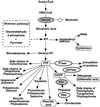Arachidonic acid alters tomato HMG expression and fruit growth and induces 3-hydroxy-3-methylglutaryl coenzyme A reductase-independent lycopene accumulation
- PMID: 9880344
- PMCID: PMC32240
- DOI: 10.1104/pp.119.1.41
Arachidonic acid alters tomato HMG expression and fruit growth and induces 3-hydroxy-3-methylglutaryl coenzyme A reductase-independent lycopene accumulation
Abstract
Regulation of isoprenoid end-product synthesis required for normal growth and development in plants is not well understood. To investigate the extent to which specific genes for the enzyme 3-hydroxy-3-methylglutaryl coenzyme A reductase (HMGR) are involved in end-product regulation, we manipulated expression of the HMG1 and HMG2 genes in tomato (Lycopersicon esculentum) fruit using arachidonic acid (AA). In developing young fruit AA blocked fruit growth, inhibited HMG1, and activated HMG2 expression. These results are consistent with other reports indicating that HMG1 expression is closely correlated with growth processes requiring phytosterol production. In mature-green fruit AA strongly induced the expression of HMG2, PSY1 (the gene for phytoene synthase), and lycopene accumulation before the normal onset of carotenoid synthesis and ripening. The induction of lycopene synthesis was not blocked by inhibition of HMGR activity using mevinolin, suggesting that cytoplasmic HMGR is not required for carotenoid synthesis. Our results are consistent with the function of an alternative plastid isoprenoid pathway (the Rohmer pathway) that appears to direct the production of carotenoids during tomato fruit ripening.
Figures





References
-
- Bach TJ. Some new aspects of isoprenoid biosynthesis in plants: a review. Lipids. 1995;30:191–202. - PubMed
-
- Bach TJ, Lichtenthaler HK. Inhibition by mevinolin of plant growth, sterol formation and pigment accumulation. Physiol Plant. 1983;59:50–60.
-
- Bach TJ, Wettstein A, Boronat A, Ferrer A, Enjuto M, Gruissem W, Narita JO (1991) Properties and molecular cloning of plant HMG-CoA reductase. In GW Patterson, WD Nes, eds, Physiology and Biochemistry of Sterols. American Oil Chemists Society, Washington, DC, pp 29–49
-
- Bartley GE, Scolnik PA. cDNA cloning, expression during development, and genome mapping of PSY2, a second tomato gene encoding phytoene synthase. J Biol Chem. 1993;268:25718–25721. - PubMed
LinkOut - more resources
Full Text Sources
Miscellaneous

